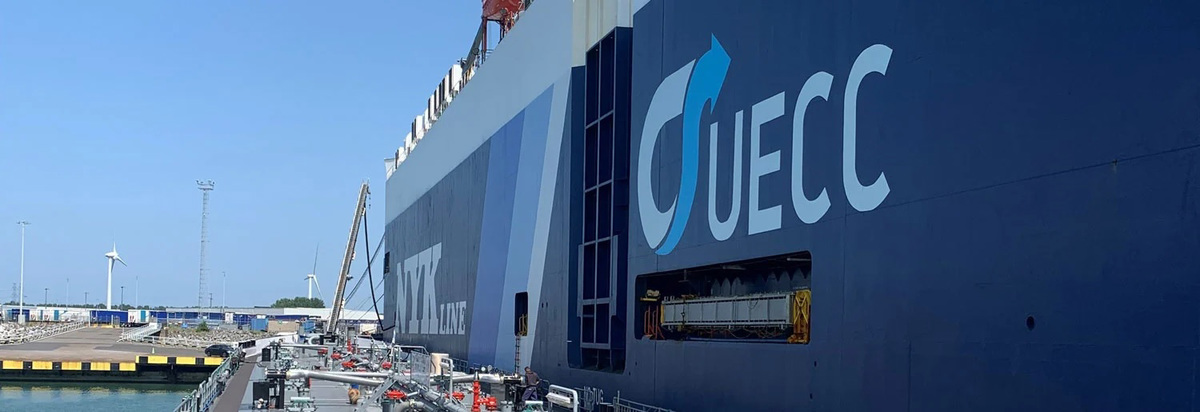Correction: Dutch government could slash marine biofuel rebate multiplier to rebalance market
The Dutch government has launched a consultation which could halve its multiplier for marine biofuel sales.
 PHOTO: The UECC time-chartered Emerald Leader being bunkered with a B30 biofuel blend in Vlissingen, Netherlands. GoodFuels
PHOTO: The UECC time-chartered Emerald Leader being bunkered with a B30 biofuel blend in Vlissingen, Netherlands. GoodFuels
The correction expands on the descriptions of the HBE system in this previously published story, and changes the HBE formula in paragraphs 4-8. It replaces inaccurate “subsidy” wording with “multiplier” and “market mechanism” throughout the text.
This multiplier has made sure that the price premiums of waste- and residue-based fatty acid methyl ester (FAME) biofuel blends over their fully conventional alternatives have been kept in check in Rotterdam and other Dutch ports.
When suppliers blend 20% or 30% used cooking oil methyl ester (UCOME) biofuel into VLSFO, they can obtain tradeable renewable energy units (HBEs) from the government that are worth $140/mt or $210/mt, respectively, on a barge basis in Rotterdam.
Depressed biofuel prices from an influx of Chinese biofuels, and strong crude and fuel oil values, have also played a part in keeping Rotterdam's price gap between biofuels and VLSFO relatively narrow compared to other major bunker ports since the beginning of the year.
The Dutch government now proposes to bring its HBE multiplier for marine fuels down from 0.8 to 0.4. This multiplier forms part of a market mechanism to boost sales of renewables and cut emissions. Bunker suppliers can obtain HBEs by selling renewable energy such as biofuel to ships. 1 gigajoule (GJ) of energy equals 1 HBE.
Verified advanced waste- and residue-based biofuels are double-counted (2 HBE-G/GJ) because of their greater environmental benefit, unlike first-generation biofuels that are typically food crop-based.
This is how much suppliers can trade HBE-Gs for from the sale of 1 mt of advanced FAME to ships:
Volume (1.12 kilolitres) x calorific value (33 GJ/kilolitres) x multiplier (0.8) x double-counting (2) x HBE-G ticket price (€11.00/GJ) x currency conversion ($1.07/€)
Halving the multiplier would make Rotterdam’s B30-VLSFO (30% biofuel with 70% VLSFO) grade about $105/mt more expensive with current prices. The outright price for that blend would go up from about $655/mt to $760/mt.
Biofuels would become pricier compared to conventional oil-based fuels, too, of course. It would increase Rotterdam’s premium of B30-VLSFO over VLSFO from around $50/mt to $155/mt.
Rotterdam's competitiveness could weaken
If the multiplier is halved, Dutch biofuels could also see their significant price edges over Singapore, Fujairah and Houston weaken. Rotterdam’s biofuel-VLSFO blends are currently priced around $200/mt lower than in Singapore, when adjusted for the different biofuel percentages in the fuels. While B20-B30 is the norm in Rotterdam, Singapore typically has a more specific B24 specification.
This $200/mt advantage could be halved in tandem with the proposed multiplier reduction.
Could this over time contribute to shift more biofuel bunker demand away from Rotterdam in favour of Singapore? Rotterdam has had a leg up on Singapore since the start, and that difference is reflected starkly in their sales statistics.
Rotterdam’s biofuel-blended bunker sales hit 186,000 mt in the second quarter of the year. That was roughly 76% more than in Singapore, which sells 10 times more total bunker fuels than Rotterdam.
Around 6% of Rotterdam’s bunker fuel sales were blended with biofuels in the first half of this year. While this was down from 8% in Rotterdam on average last year, it was still far higher than Singapore’s meagre 0.8%.
Why the government is doing this?
Biofuel supply to the road fuels market has suffered as a result of differences in prices and fuel quality between biofuels for road and marine, says Jaap Steensma, general press officer at the Dutch Ministry of Infrastructure and Water Management. This market mechanism has contributed to pull biofuel supply away from the road fuels market towards bunkering.
A rebalancing is due and a new bunker fuel multiplier has been proposed to address it, Steensma says, referring to the reasoning behind the government’s consultation.
Road fuel suppliers are mandated to blend a certain percentage of biofuels into conventional fuels, and with less access to biofuels in competition with bunkering, the concern is that road fuel suppliers will end up shorthanded.
Different quality requirements for marine and road biofuels have also reinforced the imbalance.
“Due to the difference in price and quality of biofuels used in the maritime and road sectors, supply to the road sector has decreased too much. From 2025, the government will set separate targets for the road and maritime sectors,” Steensma says.
The consultation will last until 6 October. Some anonymous comments have come in already.
“Maritime shipping is becoming more sustainable faster than expected, I say reward! No, we are going to adjust the multiplication factor. Great example for other sectors. Shifting renewable fuels from maritime shipping to other sectors is really not going to happen. Not all biofuels that can be used in maritime shipping are suitable for other modalities,” an anonymous commentator from Zaandam near Amsterdam said.
By Erik Hoffmann
Please get in touch with comments or additional info to news@engine.online






